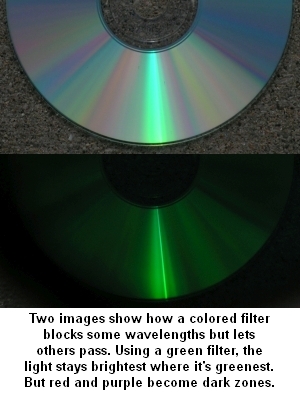¡SkyCaramba! Weekly astronomy blog for the week ending August 15, 2015
Stars come in several colors. Antares is red. Aldebaran and Arcturus are orange. Pollux is yellow. Sirius is blue. There aren’t any green stars. Why did nature skip that color when covering everything else in the spectrum from red to blue? Well, it didn’t. It just looks that way.
Stars are incandescent. That means the light they emit is the result of heat. One property of incandescent light is that it is created in a continuum of wavelengths. When you let white sunlight shine through a prism, you see a continuum of colors called a spectrum. White light is actually made of all those colors. If you still have an incandescent light bulb, you can see the same spectrum.
If you put a colored filter between your eyes and an incandescent light source, you let some wavelengths pass through more than others. The wavelengths that pass through most easily determine the color you see. That’s how a white light could be made to appear red, yellow, or green in incandescent traffic signals. It’s also how stained glass artisans make portraits in light of all colors.
Colored filters don’t actually change any of the colors passing through them. They just let some colors through more than others. So white light equally bright in all the colors becomes colored light much brighter in one color than others. Whenever you see incandescent light appearing to be of a certain color other than white, your eyes are responding to the proportion of whatever wavelengths are there. That’s true even if you change proportions by means other than a colored filter.
Stars change light proportions by turning the heat up or down. Antares burns strongly at the red end of the spectrum but weakly at the blue end. Sirius is strong at the blue end and weak at the red end. And although we can’t see it with our eyes, Antares and other red stars shine fairly strongly in infrared wavelenghths while Sirius and other blue stars shine strongly in ultraviolet. Our inability to see those wavelengths makes the red and blue stars very distinct. Our eyes are act as perfect color filters in these circumstances.
 You don’t see any green stars largely because those that shine brightest in the green part of the spectrum are also shining very strongly at the red and blue ends where we can still see the light. Remember how white light is made of all the wavelengths we can see? If any one color is only slightly brighter than the rest, our eyes can’t distinguish it. So stars that scientific equipment can determine shine strongest in green look white to us.
You don’t see any green stars largely because those that shine brightest in the green part of the spectrum are also shining very strongly at the red and blue ends where we can still see the light. Remember how white light is made of all the wavelengths we can see? If any one color is only slightly brighter than the rest, our eyes can’t distinguish it. So stars that scientific equipment can determine shine strongest in green look white to us.
Sometimes, however, you may still think you see a green star because of an adaptation our eyes do well in full light but which goes astray in the darkness of astronomical observing sessions. Perhaps you’ve never noticed that incandescent light bulbs emit a slightly reddish light compared to that of the sun or that daylight is most blue at midday. Our eyes and brain usually adjust to the color balance change without us thinking about it. But surrounded by darkness in a telescope’s eyepiece, a human eye and brain can adjust to one bright star and falsely perceive the dimmer one next to it as green.
¡SkyCaramba!